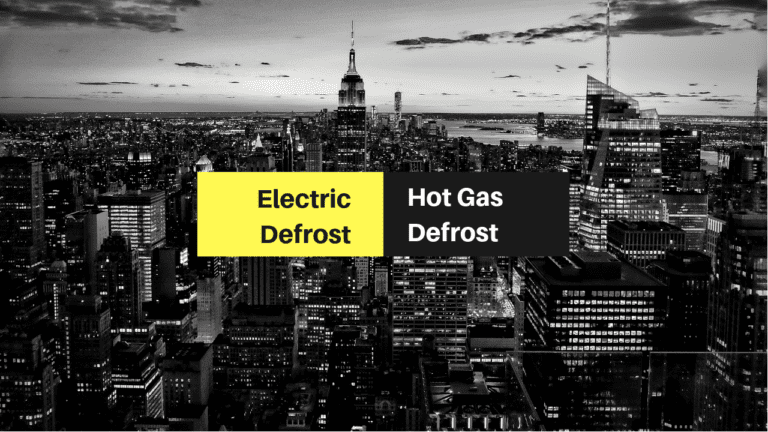
Ice accumulation on evaporator coils is a common occurrence in refrigeration systems that operate below 40°F. To prevent excessive ice buildup on the evaporator coil and ensure optimal operation of refrigeration systems, a reliable and efficient means of defrost is often required. Two commonly used defrosting methods are the electric defrost and hot gas defrost.
Electric Defrost
Electric defrost systems include electrical heating elements, which are installed along or inserted into evaporator coils. During the defrost cycle, a solenoid valve interrupts the refrigerant flow to the evaporator. Then, the electrical heating elements are energized, and the evaporator fan blows hot air over the evaporator coil, melting the ice accumulated during the refrigeration cycle.
Hot Gas Defrost
Concisely, the hot gas defrost method uses the naturally occurring high-temperature refrigerant vapor from the discharge side of the compressor to warm the evaporator coil and melt the ice accumulated on it. Although the basic concept of hot gas defrost is pretty straightforward, three different methods for introducing hot gas to evaporators have been developed over the years.
- The three-pipe system – The refrigeration systems using this method are equipped with a third pipe, also referred to as defrost line, which is connected to a solenoid valve. During the refrigeration cycle, the valve is closed, allowing the refrigerant to travel through its regular path. Once the hot gas defrost process is initiated, a system controller activates the solenoid valve and the high-pressure, high-temperature refrigerant vapor from the compressor is diverted through the defrost line, bypassing the condenser and expansion valve. The hot refrigerant vapor travels through the inlet of the evaporator, warming it from the inside out.
- Reverse cycle – This method of hot gas defrost utilizes a four-way reversing valve to direct the superheated refrigerant vapor backwards through the evaporator coil. This melts the ice accumulated on the evaporator coil and condenses the refrigerant vapor back into liquid. Then, the refrigerant passes through an expansion valve and vaporizes again as it travels backwards through the condenser. As a result, it returns as a low-pressure vapor to the compressor suction.
- Reverse flow – This method uses the existing suction line to revert the flow of the hot refrigerant vapor to the evaporator. The hot refrigerant vapor from the discharge line is piped to the evaporator through a defrost header and solenoid valve. After exiting the evaporator, the high-pressure refrigerant flows to the liquid header through the liquid line solenoid valve.
Electric Defrost versus Hot Gas Defrost
To help you select the most suitable defrosting method for your refrigeration applications, here is a side-by-side comparison of electric defrost and hot gas defrost.
|
|
Electric Defrost |
Hot Gas Defrost |
|
Design and Installation |
Electric defrost systems are relatively easy to design and install. |
Compared to electric defrost, hot gas defrost uses more complicated piping systems. Therefore, this method costs more to design and install. |
|
Efficiency
|
In electric defrost systems with heating elements installed adjacent to the evaporator coil, the heat is not fully directed to the ice block. Because a large amount of heat gets dispersed throughout the refrigerated compartment, the compressor needs to work harder to remove the excess heat. |
Because hot gas defrost uses the latent heat of the refrigerant, it consumes less energy compared to equivalent electrical systems. Furthermore, hot gas defrost systems heat up the entire evaporator coil, directing most of the thermal energy generated to the ice block. Consequently, only a small proportion of the heat is dispersed as additional load on refrigerators. Because the evaporator coil is heated from the inside, the hot gas defrost method generates less moisture compared to electric defrost systems that have heating elements installed along the evaporator coil.
|
|
Duration of Defrost Cycles
|
When the heating elements included in electric defrost systems are energized, they need some time to heat up to preset temperatures. |
In hot gas defrost systems, the refrigerant vapor is already hot when the defrost cycle begins. This aspect combined with the efficiency of hot gas defrost methods translates into a shorter defrost period. This makes refrigeration systems less suscetible to significant temperature variations between refrigeration and defrost cycles. |
Before opting for a defrosting method, it’s important to consider its effect on the system. Ideally, the number of defrost cycles in a refrigeration system should be kept to a minimum. That’s because every time the defrost cycle is initiated, sudden pressure changes put extra strain on the compressor, which will eventually cause premature failure.












